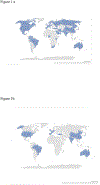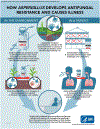The rapid emergence of antifungal-resistant human-pathogenic fungi
- PMID: 37648790
- PMCID: PMC10859884
- DOI: 10.1038/s41579-023-00960-9
The rapid emergence of antifungal-resistant human-pathogenic fungi
Abstract
During recent decades, the emergence of pathogenic fungi has posed an increasing public health threat, particularly given the limited number of antifungal drugs available to treat invasive infections. In this Review, we discuss the global emergence and spread of three emerging antifungal-resistant fungi: Candida auris, driven by global health-care transmission and possibly facilitated by climate change; azole-resistant Aspergillus fumigatus, driven by the selection facilitated by azole fungicide use in agricultural and other settings; and Trichophyton indotineae, driven by the under-regulated use of over-the-counter high-potency corticosteroid-containing antifungal creams. The diversity of the fungi themselves and the drivers of their emergence make it clear that we cannot predict what might emerge next. Therefore, vigilance is critical to monitoring fungal emergence, as well as the rise in overall antifungal resistance.
© 2023. This is a U.S. Government work and not under copyright protection in the US; foreign copyright protection may apply.
Conflict of interest statement
Figures






References
Publication types
MeSH terms
Substances
Grants and funding
LinkOut - more resources
Full Text Sources
Medical

